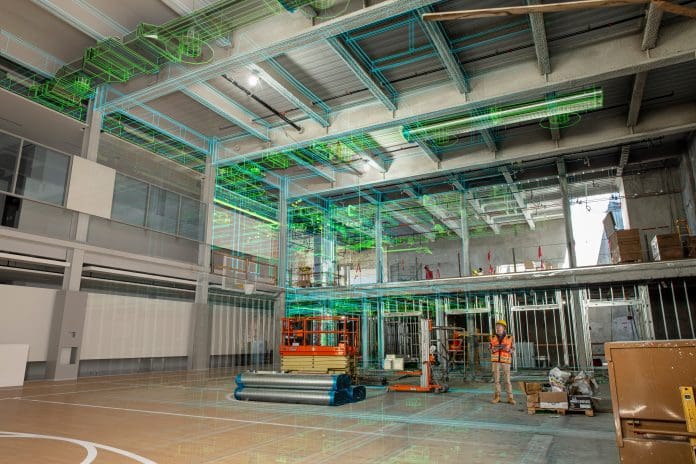In this article, FARO Technologies explores stationary and mobile scanning technologies and their uses in construction projects
For engineers in the reality capture and digital twin space, 14 November 1991 would prove a red-letter date. That’s because it’s when Oxford University Press published David Gelernter’s Mirror Worlds: Or the Day Software Puts the Universe in a Shoebox… How It Will Happen and What It Will Mean.
In his prescient work, the computer scientist-turned-author envisioned the world of tomorrow – a world where physical reality is represented, perfectly, in digital form; a living document detailing in real-time every nuance of the communities in which we live.
Thirty-two years later, for all practical purposes, we are living these predictions. Thanks to 3D laser scanning technology, stationary terrestrial and SLAM-based mobile (simultaneous localisation and mapping) every day, millions of physical assets around the world are being turned into virtual models of digital data.
Two roads, one path
But in the nearly 60-year history of terrestrial laser scanning, and the somewhat shorter history of mobile scanning, the two related but different technologies began charting separate paths.
Companies building terrestrial laser scanners (TLS) boasted of the technology’s increasing accuracy and precision, with applications ranging from reverse engineering and quality control to forensic analysis for public safety, to point cloud-based modelling for the architecture, engineering and construction industry.
Mobile scanning companies, aware of their products’ data granularity limitations, instead promoted their technology’s speed of data capture, ease-of-use, cost savings, and mobility.
Today, however, these once-divergent roads are linking up. It’s a transformation led by innovative companies on both sides of the reality capture industry and it’s happening for two reasons:
- The realisation that especially in AEC and mining applications, the mobile versus stationary bifurcation has proved more nuanced; there are in fact many examples where both high-resolution terrestrial scans and fast lower-resolution mobile scans are useful in a single project.
- Advances in SLAM-based software algorithms, data processing speeds and online and offline workflows are helping bring stationary and mobile scanning technology into unified hardware and software systems – in these scenarios, mobile scanning devices are essentially doing “double duty” bringing the best of both worlds together.
In other words, “good enough” may still be “good enough” for the vast majority of mobile scanning applications.
But when the technology does fall short, or a specific use case arises within a mining or AEC project, stationary scanning can complete the data picture, filling in gaps that a mobile scan may miss.
Examples of these types of applications are varied. For AEC, as with mining, production progress mapping/project oversight is particularly important.
Both industries have numerous stakeholders involved and many of these stakeholders are located thousands of miles away from a project site or mine.
A SLAM-based mobile scan can capture a large volume space, without the need for GPS triangulation with good enough quality and provide a necessary overview of where a project stands.
The way it works is simple: point clouds are processed in a software program and compared against earlier scans or CAD models. Once complete, a digital file is generated and sent to those stakeholders.
While a traditional stationary 3D laser scanner can accomplish this aim, a mobile scanner can do it well enough, at a more competitive price point, and at much faster speeds, which can accelerate an entire build. This is the essential argument for mobile scans.
But within that same hypothetical project, there are areas where a stationary scan makes the most sense. This is often evident in MEP (mechanical, electrical and plumbing) applications.
Here, the granularity needed to capture all the detailed piping within a building, or self-contained in an MEP room, exceeds the capabilities of a mobile scan. This is where a terrestrial laser scanner – or something close – makes the most sense. The same holds true in mining applications.
While a mobile scanner might be great for the above-mentioned convergence analysis, production progress mapping, vertical shaft inspection and stockpile volume, the technology is less ideal for when a project calls for a detailed analysis of the structure and configuration of a particular geological formation.
Likewise for mine design and planning, ensuring that new tunnels, ramps and excavations align with existing infrastructure and geological features.
The timeless wisdom of “two for the price of one”
As both technologies have continued to advance, increasingly what the market will see are “merged” devices – mobile scanners that include stationary scanning capabilities – even if those capabilities might not fully replace a TLS (at least not yet).
The benefits of such a hybrid device are clear. A mobile scanner that can take in-motion as well as high-quality stationary scans will:
- Reduce the cost of purchase.
- Streamline a company’s laser scanning arsenal.
- Increase mobility of use.
- Simplify software systems.
- Decrease on-site weight and bulk.
- Speed project completion.
Thus, terrestrial laser/mobile scanning and its attendant hardware and software applications are not only groundbreaking in their own right but are becoming foundational to how the world collects, processes and shares data.
This is especially true in AEC and mining applications, where both stationary and mobile scanning continue to prove their worth. But it’s also the case in other sectors, including education, security and defence, utility and power generation companies, government and transport and logistics services.
Amanda Hidalgo
Office of Corporate Communications
FARO Technologies
Tel: +1 700-161-1036
*Please note: This is a commercial profile.














